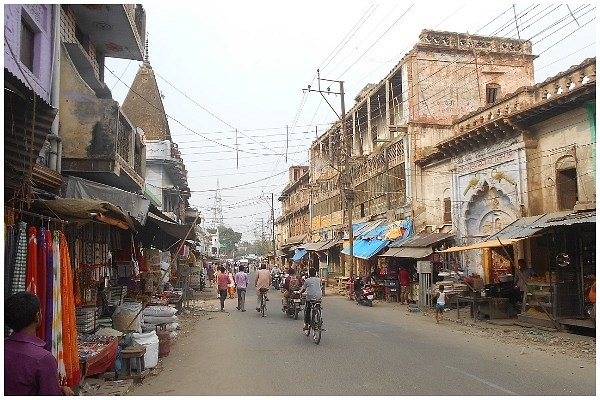Ideas
Mandir-Masjid Dispute Was Like Article 370 Imposition On Ayodhya; Temple Will Transform City’s Fortunes
- To be sure, the Yogi Adityanath administration has been giving Ayodhya the attention it deserves. But it is the Ram mandir which likely holds the key to its overall transformation.

A street in Ayodhya (Wikimedia Commons)
I had the good fortune of visiting Ayodhya on Deepavali last year (7 November) and having darshan of Ram Lalla under the tent protected by rings and rings of military personnel in the 70-acre complex including the disputed 2.77 acres on which the Supreme Court pronounced its verdict yesterday (9 November).
While talking to the locals — be they saints, shopkeepers or commoners (including Muslim residents), it became obvious that the decades-long mandir-masjid dispute had become the primary stumbling block in Ayodhya’s development.
It was akin to imposing Article 370 on the city.
Article 370, which became synonymous with keeping Jammu and Kashmir poor and backward since the mid-1950s, was recently revoked by the Parliament.
Now, by declaring a clear verdict in favour of building the temple, the judiciary has lifted Article 370-like conditions in Ayodhya and opened the doors to the city’s transformation.
During my visit last year, I met the head of Ayodhya Saints Committee, Mahant Kanhaiyadas Ramayani. He explained how the city’s development was obstructed due to the Janmabhoomi dispute:
Anyone who has been to Ayodhya would testify to the backwardness.
Mahatma Gandhi, who envisioned that the modern independent Indian state follow the ideals of Shri Ram also had ‘Ram Rajya’ in mind. He was instrumental in popularising the term in the political discourse of the nation.
In this regard, it’s the Bharatiya Janata Party (BJP) which has taken the baton from Gandhi and is running with it.
But for seven decades, the modern Indian state ignored Ayodhya, let alone caring about Ram Rajya.
Only in 2017, when the BJP came to power in Uttar Pradesh and Yogi Adityanath became chief minister, did this ancient city started getting some attention.
Between 2002 and 2017, UP chief ministers Mulayam Singh Yadav, Mayawati and Akhilesh Yadav wouldn’t even visit Ayodhya, let alone announce any big development works for this important city.
On the other hand, CM Adityanath has been to Ayodhya 18 times in the past two-and-a-half years alone.
Ayodhya was merely a municipal council when he took the reins of the state. It was first declared as a corporation in December 2017 and later, Faizabad district was named as Ayodhya, last Deepawali. This move alone has opened many doors for the city’s development.
The Yogi government has been organising grand Deepotsav celebrations every Deepawali when the entire city is lit up and decorated like no other in India.
This event has put Ayodhya back on the country’s map and people from all over have started visiting to witness the celebration, which goes on for many days.
The local economy has also got a fillip due to the government’s efforts to give it a facelift.
Before 2017, power supply in Ayodhya was erratic and hours-long electricity cuts were the norm. But now, the government is supplying power round-the-clock.
The water at the famous Ram Ki Paudi is now fresh and flows uninterrupted unlike earlier when it used to stink and the steps on the paudi remained dirty.
After the city got municipal corporation status, waste disposal and cleaning drives have helped improved the swachhta at all important places.
The government is installing LED lights at all vantage points to ensure illumination at night.
New ghats are being built (such as at Guptar Ghar) and the old ones are being repaired. Roads which had turned into narrow lanes due to encroachment by shops and shanties have been cleared in some parts of the city.
Main roads are also being widened. Sewage facilities and waste management, which were non-existent until a couple of years ago, are coming up too.
A new medical college named after Raja Dashrath started MBBS classes this year. The Yogi government has already promised to convert the airstrip in Ayodhya into a full- fledged airport and has allocated money for the same in the latest budget as well.
The land acquisition for the same is currently under way.
The state government has announced plans to build a ‘New Ayodhya’ township on 500 acres, close to the banks of the Sarayu. This will stretch into neighbouing villages and the township will have residential areas, luxury hotels, public spaces, parks, temples and shopping arcades.
The government has already started work on building the world’s tallest statue of Shri Ram (221 metres) on the Sarayu riverfront.
It will have a museum attached to it. The complex comprising of a statue and a museum will be spread over 150 acres, more than double the size of the Ram Temple complex.
Ayodhya people believe that while the Ram mandir will attract the pious and devotees, the statue will woo the tourists.
It’s a double bonanza for the region’s economy.
Now, with the Ram temple on its way, the city’s fortunes are sure to turn for the better.
How?
Shubham Gupta, a shopkeeper who runs a carpet-and-drape shop near Raja Janak Mahal, told me last year that,
Article 370 on Ayodhya has been repealed by the judiciary. Vikas will follow.
Introducing ElectionsHQ + 50 Ground Reports Project
The 2024 elections might seem easy to guess, but there are some important questions that shouldn't be missed.
Do freebies still sway voters? Do people prioritise infrastructure when voting? How will Punjab vote?
The answers to these questions provide great insights into where we, as a country, are headed in the years to come.
Swarajya is starting a project with an aim to do 50 solid ground stories and a smart commentary service on WhatsApp, a one-of-a-kind. We'd love your support during this election season.
Click below to contribute.
Latest